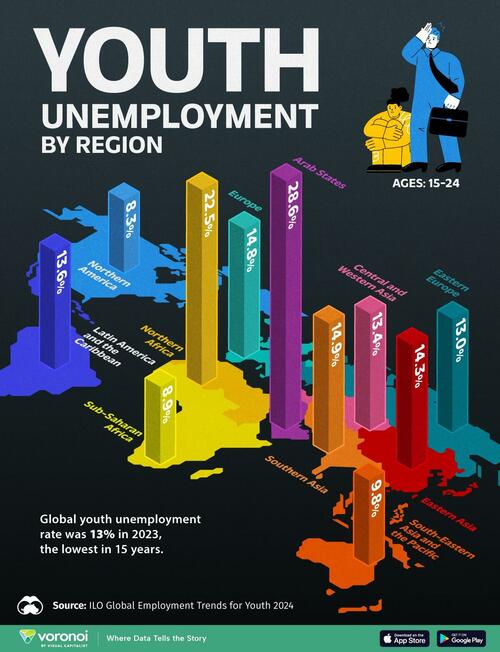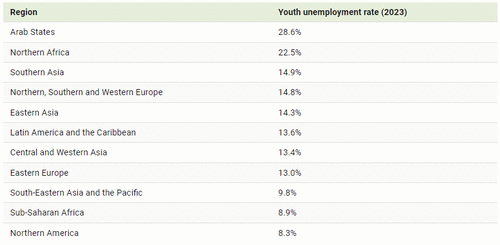
According to the International Labour Organization (ILO), youth unemployment hit its lowest level in the past 15 years in 2023, at 13%, marking a strong recovery from the high rates during the COVID-19 pandemic.
However, these unemployment figures vary significantly by geographical region.
This map, via Visual Capitalist's Kayla Zhu, visualizes youth unemployment rates by global region in 2023. Youth are defined as individuals between the ages of 15 to 24.
The data comes from the International Labour Organization’s 2024 Global Employment Trends for Youth 2024 report.
Which Region has the Highest Youth Unemployment?
Below, we show youth unemployment rates by region in 2023.
The Arab States, consisting of countries like Saudi Arabia, United Arab Emirates, Qatar, Yemen, and others, recorded the highest (28.6%) youth unemployment rate globally, with Northern Africa, consisting of countries like Algeria, Egypt, and Morocco, following closely behind at 22.5%.
According to the Brookings Institution, youth unemployment rates in the MENA (Middle East and North Africa) region have been the highest in the world for over 25 years.
In 2019, just before the onset of the COVID-19 pandemic, 30% of youth in the MENA region were NEET–not in education, employment, or training, according to the ILO.
Experts say the combination of low infant mortality rates and high fertility rates, which translated into high labor force growth rates from 1970 onwards could be a leading cause of the high youth unemployment rates in the region.
In contrast, the Northern America region saw the lowest youth unemployment rate in 2023, at only 8.3%. The U.S. saw a significant decrease in the youth unemployment rate last year, with young workers seeing the lowest unemployment rate in 70 years at 7.5% in March of 2023.
However, in the first half of 2024, both the U.S. and Canada both have seen increases in youth unemployment rates.
To learn more about youth employment, check out this graphic that show employment rates for U.S. college and high school students since 1993.
According to the International Labour Organization (ILO), youth unemployment hit its lowest level in the past 15 years in 2023, at 13%, marking a strong recovery from the high rates during the COVID-19 pandemic.
However, these unemployment figures vary significantly by geographical region.
This map, via Visual Capitalist’s Kayla Zhu, visualizes youth unemployment rates by global region in 2023. Youth are defined as individuals between the ages of 15 to 24.
The data comes from the International Labour Organization’s 2024 Global Employment Trends for Youth 2024 report.
Which Region has the Highest Youth Unemployment?
Below, we show youth unemployment rates by region in 2023.
The Arab States, consisting of countries like Saudi Arabia, United Arab Emirates, Qatar, Yemen, and others, recorded the highest (28.6%) youth unemployment rate globally, with Northern Africa, consisting of countries like Algeria, Egypt, and Morocco, following closely behind at 22.5%.
According to the Brookings Institution, youth unemployment rates in the MENA (Middle East and North Africa) region have been the highest in the world for over 25 years.
In 2019, just before the onset of the COVID-19 pandemic, 30% of youth in the MENA region were NEET–not in education, employment, or training, according to the ILO.
Experts say the combination of low infant mortality rates and high fertility rates, which translated into high labor force growth rates from 1970 onwards could be a leading cause of the high youth unemployment rates in the region.
In contrast, the Northern America region saw the lowest youth unemployment rate in 2023, at only 8.3%. The U.S. saw a significant decrease in the youth unemployment rate last year, with young workers seeing the lowest unemployment rate in 70 years at 7.5% in March of 2023.
However, in the first half of 2024, both the U.S. and Canada both have seen increases in youth unemployment rates.
To learn more about youth employment, check out this graphic that show employment rates for U.S. college and high school students since 1993.
Loading…





